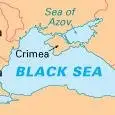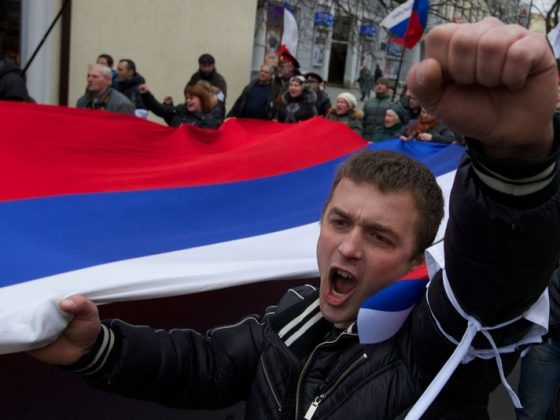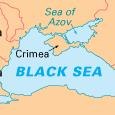The Ukraine crisis altered the security landscape of the Black Sea region. This area was a relatively quiet “battlefront” during the Cold War and a rather stable region in the post-Soviet period, even with its “frozen conflicts” and the occasional flare-up of conflict, most notably the August 2008 war between Russia and Georgia. This has all changed with Russia’s annexation of Crimea and its continuous intervention in Ukraine’s east. Russia’s intervention in Crimea and the Donbas has shown that the use of force still matters, especially when it promises to achieve results more quickly and effectively than diplomacy. This lesson has reverberated across the Black Sea region. Together with the souring of Russian-Turkish relations over the conflict in Syria, the turbulence created by Russia’s actions is leading to a noticeably different strategic environment.
[Also see: Mitat Çelikpala & Dimitrios Triantaphyllou, The Changing Face of Black Sea Security, May 31]
Russia’s Increased Power Projection
Crimea has always occupied a strategic position in the Black Sea. Great powers fought for control of the peninsula for centuries. Russia’s de facto control now allows for considerably greater power projection, both in the region and beyond. Thanks to a long-term lease with Kyiv, Russia had a limited military presence in Crimea for years, but after annexing the peninsula Russia has embarked on an accelerated and ambitious military build-up. The process of expanding and modernizing the Black Sea fleet is underway, and new submarines and frigates have been commissioned. This has been coupled with an increase in land and air forces, leading to the presence of a significant joint strike force that appears to be more offensive than defensive.
New Russian military and strategic doctrines assign an essential role to Crimea. In this, Moscow’s hands are untied. Russia suspended its participation in the Treaty on Conventional Armed Forces in Europe (CFE) in 2007, and then withdrew in March 2015, leaving it free to militarize Crimea at will. Russia has placed in Crimea Iskander ballistic missiles, which cover large portions of the Black Sea region, including in Ukraine, Moldova, Romania, and Turkey. Russia has even emphasized its alleged right to deploy nuclear weapons in Crimea, and already there are strategic nuclear-capable bombers stationed in the peninsula.
Russian control over the Kerch Strait has also basically cut off access to and from the Azov Sea. In addition, one underappreciated outcome of Crimea’s annexation is that Russia has taken control of Ukraine’s rich offshore oil and gas resources, delivering a terrible blow to Ukraine’s ambitious plans for eventually achieving energy independence.
The Reaction of Regional Actors
This shift in Russian capabilities, however, has altered perceptions of relative power in the Black Sea region beyond Ukraine. Russia’s naval capabilities have long been vastly inferior to those of NATO and, specifically, of the largest maritime force in the region, Turkey. The latter continues to enjoy its dominance, but the trend of increasing Russian power is unsettling. These circumstances could eventually produce a local arms race.
Turkey’s role since the Crimea annexation was initially ambivalent. Ankara formally criticized Russia’s aggression and declared its support for the inviolability of Ukraine’s territorial integrity. At the same time, Turkey took no action and did not sanction Russia. In fact, Turkey benefited enormously from Western sanctions as they increased Turkish trade with Russia. The most important elements of the Russo-Turkish partnership—substantial mutual trade, energy cooperation, massive tourist influxes from Russia to Turkey—appeared to be undamaged.
This changed after Turkey downed a Russian military jet that had entered Turkish airspace at the end of November 2015. Bilateral relations are unlikely to return to pre-incident levels. The notion that the Black Sea region could be kept under a kind of Russian-Turkish condominium that preserves the region as a “lake” of peace and stability no longer looks so convincing.
Smaller regional states like Romania and Bulgaria have more reason to be alarmed. These NATO members rely fully on the alliance’s security guarantees. The U.S. and NATO military presence in these states was limited prior to the Ukraine conflict, mainly to provide support for coalition operations in Afghanistan and Iraq. Romania also hosts a key new site for NATO’s European missile defense system. Both Bucharest and Sofia have been welcoming of new ideas and initiatives to boost their own defenses. However, they have grown impatient by NATO’s relatively slow efforts to adapt to the changing situation. They have expressed interest in bilateral defense and security cooperation and also seem to favor a continued—and possibly expanded—U.S. military presence.
“Frozen” Conflicts Even Further From Solutions
The strategic environment has also changed with regard to the Black Sea region’s so-called “frozen conflicts.” Since March 2014, Russia has brought Abkhazia and South Ossetia more tightly under its control. The Armenian–Azerbaijani conflict over Nagorno-Karabakh has escalated. Finally, the prospects for achieving a settlement over Transnistria, the one conflict observers believed could be solved, now seem dim, as Moscow has renewed its efforts to keep this enclave under its control.
The Limited Role of the EU
The EU has had a long history of neglecting the Black Sea region. Reacting to criticism of this, the EU launched a Black Sea Synergy program in 2008, which was quickly seen as a surrogate for a more responsible and proactive regional strategy. Even with two EU members in the region, the EU has not really become a regional player.
Moreover, the Ukraine crisis, like others the EU has been dealing with lately, has shown that the EU is far from able to pursue a coherent security, foreign, and defense policy. The EU responded to Russia’s annexation and intervention with condemnation and sanctions. But it basically subcontracted its efforts to achieve a resolution of the crisis to two of its members, Germany and France.
Stepping Up NATO
For now, NATO is trying to walk the line between developing an appropriate response to Russian aggression, on the one hand, and avoiding the start of a new Cold War, on the other. In the Alliance’s approach, the Baltic region has emerged as a priority. Whether the Black Sea region will become a similar focus for NATO remains an open question. For years, NATO has avoided formulating a concrete Black Sea strategy, but perhaps this will now change.
It has become clear that some older local security initiatives aimed at providing for the security of the region, notably “Black Sea Harmony” and “BLACKSEAFOR” have failed most dramatically. The main supporter of these initiatives is Turkey, which has traditionally opposed a greater NATO presence in the region. Now, however, it is bolstering its role not just as an individual state and regional power but as a member of a broader security alliance with 27 other countries behind its back.
This comment is derived from a PONARS Eurasias workshop held in Istanbul, February 4-6, 2016.
Also see:
Mitat Çelikpala and Dimitrios Triantaphyllou, The Changing Face of Black Sea Security, PONARS Eurasia Commentary, May 31, 2016











